by Naomi L. | January 29, 2014 | Blog, Creative Writing |
Lately there have been plenty of thunderstorms where I live. And as we all know, with thunderstorms often come power outages, or “blackouts”, if you will. Now I’ll be honest: I’m not a fan of blackouts. Storms fascinate me, and I enjoy watching the occasional lightning show outside my window, but when it means taking out the electricity that powers my computer and router, I can’t say I really care for it. There is an upside to blackouts, though, and the most recent ones in my area have inspired (read: practically forced) me to write this post.
 Let me start off by making a slightly embarrassing confession: I’m completely addicted to technology. I have trouble getting off the Internet for longer than an hour, I take an iPod with me every time I leave the house, and I always go to sleep well after midnight because I just can’t tear myself away from the screen before getting one more idea typed out. So the occasional abstinence from that addiction is probably healthy, especially for someone as hooked on electronics as me.
Let me start off by making a slightly embarrassing confession: I’m completely addicted to technology. I have trouble getting off the Internet for longer than an hour, I take an iPod with me every time I leave the house, and I always go to sleep well after midnight because I just can’t tear myself away from the screen before getting one more idea typed out. So the occasional abstinence from that addiction is probably healthy, especially for someone as hooked on electronics as me.
The thing is, electronic devices, despite all their practicality, are a major distraction. From what, you ask? Well, that depends on what type of person you would be without modern technology in your life. And as a writer, the type of person I would probably be is one who can frequently think up new ideas and write nonstop until a whole novel is done. But my gadgets always seem to draw my attention away from the tasks on which I should be focusing most.
Enter the power outage. Yes, I do get annoyed at first when a bad storm takes out the electricity; no TV or Internet means I can’t kill time on some of my favorite hobbies, and though I do work on a laptop, it’s already over four years old and the battery just doesn’t stay charged as long as it used to, so I prefer to leave it asleep. But I find that all these gadgets off allow for the quiet time in which some of my most creative ideas often emerge.
It’s kind of like meditation, really. I’m too easily distracted by the technology around me, and too addicted to drop it at a moment’s notice (without suffering withdrawals, of course). Yet I love taking the occasional break just to daydream, and when I can’t be drawn back to my electronic devices right away, those breaks can last even longer, providing extra time for a good story to come to me. On top of that, I have more time for hobbies like reading books, listening to music, and other activities that help me get inspired for writing.
So if you have a stronger willpower than I do when it comes to technology, I highly recommend taking long breaks from it once in a while, at least enough to let your ideas flow without distraction. And if you are like me, thoroughly annoyed throughout the first minutes of a blackout, try to think of it as an opportunity to set your creative spirit free. Maybe all it wants is a chance to breathe.
Are you as hooked on technology as I am (or worse)? Do blackouts ever help you keep your addiction in check, or are they just a reason for angst?
by Naomi L. | January 22, 2014 | Blog, Creative Writing, Off The Bookshelf |
I wanted to start this year’s Off The Bookshelf posts with a review of a beautiful story that I finally got around to reading recently. I know I really should have read it (or rather, finished reading it) a long time ago, and after I did, I realized what I had been missing since I was a kid. So long overdue, here is a review of a classic tale by a French aviator and author: The Little Prince, by Antoine de Saint-Exupéry.

The Little Prince, by Antoine de Saint-Exupéry
Summary
The Little Prince (or Le Petit Prince, in its original French title) was first published in 1943 by Reynal & Hitchcock, in both English and French. Narrated in the first person, the book tells the story of a pilot who ends up stranded in the desert, where he meets a strange boy from a distant and tiny “planet” (which is really an asteroid). Over the eight days it takes him to fix his plane, the narrator gets to know the story of this “Little Prince”, from the life he had on his planet to the journey that brought him to Earth. The Little Prince enchants the pilot with his eccentric and poetic outlook on the world, and when the time comes for both of them to return home, the narrator is utterly heartbroken to lose the only friend he’s ever known who could appreciate life with the beautiful innocence of a child.
Review
What stands out most about this book is how it criticizes the “adult” way of thinking. The story begins with the narrator telling his readers how he was discouraged from pursuing art by grown-ups who couldn’t comprehend his drawings when he was younger. Since that time, the Little Prince was the first person he ever met who understood the vision he had as a child. Still very young himself, the Prince thus represents the simple way children see the world in contrast to the analytical views of adults, and does so in a way that makes the former much more appealing.
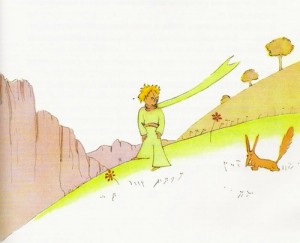
The Little Prince and the Fox
(Illustration by Antoine de Saint-Exupéry)
Though appearing to be a children’s book, The Little Prince is arguably targeted at adults who have forgotten how to understand the world the way they should. We as mature readers have it constantly pointed out to us that our manners are flawed, that we are too concerned with “matters of consequence”. Basically, we’ve become so focused on trivial details that we’ve lost sight of the things that are truly important. Perhaps this idea is most evident in a scene involving another well-spoken character of the story: a fox that the prince meets on his journey through Earth.
One sees clearly only with the heart. What is essential is invisible to the eye.
– The Fox, The Little Prince (Antoine de Saint-Exupéry, 1943)
The Little Prince is a charming tale fit for readers of all ages. For adults, it’s a reminder of the lessons that can be learned from youth, many of which may have been lost long ago. As for children, they can find embedded in these pages the encouragement to keep living their own special way, and, if nothing else, a friend who can teach them the real matters of so much importance.
Inspiration
If there’s one thing I loved most about this book, it was the way it constantly reminded me how I used to see the world when I was a little girl (and how I probably should see it again as a woman). Living in a world that seems to demand we grow up as quickly as possible, it’s easy to forget what it’s like to experience life through the innocent eyes of children. The Little Prince’s questions and observations, coupled with the grown-ups’ awkward answers, served as a lesson on how I should never lose touch with the curious child still in my heart, for to do so would be like losing a very special friend.
Overall, I enjoyed this book very much. Though it did break my heart a little, it was wonderful to read a story that could effortlessly shine light on the poetry children can bring to the world. The Little Prince has a lovely perspective on life, and after reading his story, I only hope I can remember to keep setting my inner child free. She is, after all, a very important friend to the grown-up writer I’ve become.
by Naomi L. | December 18, 2013 | Blog, Creative Writing, Off The Bookshelf |
It’s the holiday season, and that means it’s the perfect time to share a blog post about a Christmas-themed story! I had originally planned this post for next week (Christmas Day), but when I realized Christmas is also the last Wednesday of the year, I decided to bump this review up and save next week for a special post instead. So here it is a week early, a review of another of my favorite Dr. Seuss books: How The Grinch Stole Christmas!
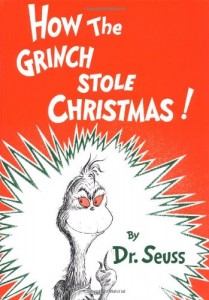
How The Grinch Stole Christmas!, by Dr. Seuss
Summary
Every Who down in Whoville liked Christmas a lot,
But the Grinch, who lived just north of Whoville, did NOT!
– How The Grinch Stole Christmas! (Dr. Seuss, 1957)
Originally published by Random House in 1957, How The Grinch Stole Christmas! tells the story of a grouchy creature known as the Grinch and his plot to ruin Christmas for the town of Whoville, located just south of his cave on Mount Crumpet. Annoyed every year by the festivities of the warm-hearted Whos, he dons a makeshift Santa Claus costume and descends into Whoville on Christmas Eve to steal all their presents, food and decorations, in the hope of stopping the holiday from ever arriving. Come Christmas morning, however, he is surprised to find that despite his best efforts to discourage them, the Whos still have the spirit of Christmas in them, and that day, the Grinch learns a valuable lesson about the true meaning of the holiday season.
Review
I’ve always appreciated How The Grinch Stole Christmas! for its uplifting message about the holiday spirit. With all the commercialization that Christmas has undergone over time, it’s easy to lose sight of the simpler things we should enjoy during the holidays, such as the company of our loved ones and all the possibilities that come with a new year. Puzzled to hear the Whos singing on Christmas morning, the Grinch starts to wonder why his plan didn’t work, and comes to a heartwarming revelation.
Maybe Christmas, he thought, doesn’t come from a store.
Maybe Christmas, perhaps, means a little bit more.
It probably goes without saying that the author’s intention with this story was to criticize the commercialization of Christmas. Interestingly, the Grinch has been compared to Seuss himself, who claimed to have found inspiration for the character after seeing a “Grinchy” face in the mirror on December 26th. His idea was to write this sour character in order to rediscover the meaning of Christmas, which he felt had been lost on him at some point in the past. The same way he did with Horton Hears a Who!, Dr. Seuss drew from his own life experience to tell a heartwarming story that readers of all ages can enjoy for its important lesson.
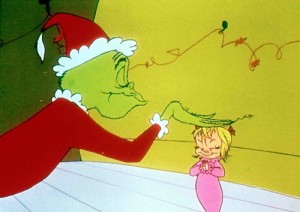
The Grinch and Cindy Lou Who, How The Grinch Stole Christmas! (1966)
Like most of Dr. Seuss’s children’s books, How The Grinch Stole Christmas! is written in rhyming verse and illustrated with colorful and bizarre characters, making it a fun and memorable read for the whole family. A noteworthy adaptation of the book is the 1966 TV special directed by Chuck Jones (of Looney Tunes fame). I remember watching it often as a kid and smiling every time the Grinch’s heart grew three sizes at the end of the story (not to mention Cindy Lou Who was probably the sweetest little thing I’d ever seen in a classic cartoon). It’s an adaptation I’d highly recommend, so if you haven’t seen it yet and it runs annually on TV in your region, be sure to watch it this holiday season! And while you’re at it, you may want to read the book again; it’s truly a Christmas classic!
Inspiration
What I find most inspiring about this book is the way it never fails to fill me with holiday cheer, regardless of the time of year. I enjoy a good story where the villain is the main character, and seeing the Grinch embrace the Christmas spirit helps me remember that there’s more to the holidays than presents (not that I ever needed much reminding, with a wonderful family like mine).
Overall, How The Grinch Stole Christmas! is a very enjoyable read, and one that should definitely be on every Seuss fan’s bookshelf. Whether I’m in the mood for his fun stories and illustrations or for his good life lessons, I always find something wonderful to enjoy in Dr. Seuss’s charming holiday tale! Enjoy, and have a very Merry Christmas!
by Naomi L. | November 27, 2013 | Blog, Creative Writing, Off The Bookshelf |
Since last week’s post was dedicated to the amazing children’s author Dr. Seuss, I wanted to follow it up with a post about one of his many wonderful books. However, the more I thought about it, the more I realized how hard it would be to choose which book to feature; there are so many good stories by Seuss that it’s almost impossible to choose just one favorite. Eventually, though, I settled on one of the books I find most inspiring: Horton Hears a Who!
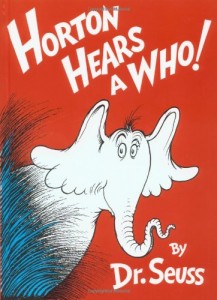
Horton Hears a Who!, by Dr. Seuss
Summary
First published in 1954 by Random House, Horton Hears a Who! tells the story of Horton the Elephant, a resident of the Jungle of Nool, and his quest to help the Whos. After hearing a small yelp coming seemingly out of thin air, Horton discovers the microscopic civilization of Whoville living on a speck of dust. Deciding that every life has value regardless of size, he places the speck on a clover and sets out to find a safe location to keep the Whos out of harm’s way. Unfortunately, being the only one with ears keen enough to hear these tiny people, the elephant has trouble convincing the other jungle residents that Whoville exists, and when they decide to put an end to his crazy antics by destroying the clover, Horton must struggle to save his new friends and teach the people of the Jungle of Nool an important lesson: “a person’s a person, no matter how small”.
Review
Horton the Elephant is one of my favorite Dr. Seuss characters, mostly for his kindness and integrity. He stays true to his word no matter what; as seen in the previous story featuring his character – Horton Hatches the Egg – when Horton makes a promise, he has every intention of seeing it through, and that makes him one of the best role models in Seuss’s stories.
I meant what I said
And I said what I meant.
An elephant’s faithful,
One hundred per cent!
– Horton the Elephant, Horton Hatches the Egg (Dr. Seuss, 1954)
Like many of Dr. Seuss’s books, Horton Hears a Who! is more than just a children’s story. It also teaches good lessons, such as the importance of open-mindedness and understanding the issues of isolationism. Horton’s biggest challenge is convincing his peers that something they can’t perceive or fathom actually exists – which, when you think about it, is a story that’s only too familiar in real life. But what’s really interesting about this book is the history behind its lessons. Once strongly opposed to Japan, the author changed his opinions after World War II, and used this book as an analogy for the American post-war occupation, even dedicating the book to a Japanese friend. Overall, the metaphor of two worlds overlapping creates a beautiful message, one that children can certainly understand and appreciate.
Horton Hears a Who! is one of Seuss’s most notable works. From the children’s book to the TV special to the 2008 full-length feature film (which I thoroughly enjoyed; I swear the “We are here!” scene gives me chills every time I watch it), this story is wonderfully imaginative and fun for readers and viewers of all ages. Though they may have been written for a young audience, no one is too old to enjoy the stories of the great Dr. Seuss!
Inspiration
What I always found inspiring about this book was the main character’s determination to help an entire community that he couldn’t even see. I admired Horton’s devotion to his cause, and the respect he had for all forms of life made him a truly lovable hero. With colorful characters, adventure and a heartwarming message, Horton Hears a Who! is one of my favorite Dr. Seuss stories, and one I’ll definitely enjoy for the rest of my life.
by Naomi L. | November 20, 2013 | Blog, Creative Writing, Notable Authors |
I’ve been feeling a little nostalgic lately: looking through my books for old favorites, watching movies from my childhood whenever they’re on TV, even listening to songs from the ’90s once in a while. That’s how I recently had an idea for another post on inspiration, because when I think about my childhood, one of the most prominent figures that comes to mind is the author of some of my favorite classics of children’s literature: Dr. Seuss.
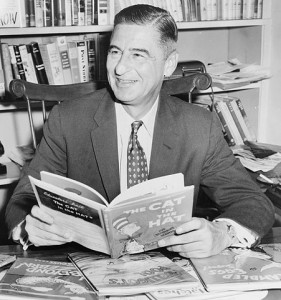
Theodor Geisel in 1957
Bio
Name: Theodor Seuss Geisel
Pen Name: Dr. Seuss
Life: Mar. 2, 1904 – Sept. 24, 1991
Gender: male
Nationality: American
Occupation: writer, cartoonist, animator, publisher, artist
Genres: children’s literature
Notable Works: The Cat in the Hat, Horton Hears a Who!, Green Eggs and Ham
My Favorite Works: The Cat in the Hat, The Sneetches and Other Stories, Horton Hears a Who!, How the Grinch Stole Christmas!
Inspiration
Dr. Seuss was a huge part of my childhood. When I was little, my mother signed us up for the Dr. Seuss book club, so we would get one of his books in the mail every month. By the time I started reading on my own, I had a large collection of fun stories to choose from, such as The Cat in the Hat, Horton Hears a Who! and Green Eggs and Ham. Because of this, my earliest memories of reading were filled with colorful characters and silly rhymes that kept me entertained for hours on end. If I ever wanted to get lost in books, I could always count on Seuss’s imaginative world.
The main reason I find this author so inspiring is because his stories were an important first step into my love of books. Sometimes I wonder if I would have grown to love reading as much as I do today if I hadn’t had the privilege of enjoying Dr. Seuss’s work at such a young age. His books were very easy to read and understand, and that always made reading such a pleasure. In fact, his rhymes and style of writing were so memorable that to this day, my mom and I can quote lines word for word back to each other. In this way, Seuss gave us the gift of memories that we could share for the rest of our lives.
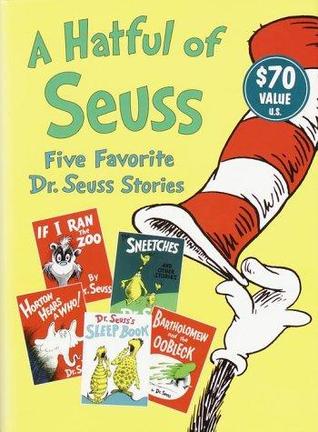
A Hatful of Seuss: Five Favorite Dr. Seuss Stories
But there was much more to these books than simple rhymes and oddly shaped characters with bizarre names. Dr. Seuss had a talent for embedding important lessons in his stories without making them blatantly obvious or patronizing. Moral issues are cleverly hidden behind tales of strange creatures living in unusual worlds: The Sneetches shows us that racism is unjustified; The Lorax shines light on environmentalism and the dangers of corporate greed to the natural world; How the Grinch Stole Christmas! criticizes the commercialization that the holiday season has suffered over time; and even a story as simple as Green Eggs and Ham can be read as a lesson on trying new things in order to form educated opinions. There was almost always something to learn in Seuss’s books, and because the lessons were presented in such a kid-friendly format (complete with his colorful illustrations), it made his stories that much more accessible to children just starting to discover the world around them.
There are quite a few authors I associate with my childhood, but Dr. Seuss is by far one of my favorites. His books inspired me to continue reading beyond the beginner level, and the lessons in his stories have stayed with me into my adult years. Even now, I can’t help but smile as I think about how I once knew The Sneetches by heart and how I still enjoy reading Horton Hears a Who! out loud once in a while. Though authors like Roald Dahl and J.K. Rowling were great inspirations for my writing, Dr. Seuss was a great inspiration for my reading, and in my opinion, there’s no greater gift that a writer can give to children. To the little girl still in my heart, Dr. Seuss will always be a hero.
 Let me start off by making a slightly embarrassing confession: I’m completely addicted to technology. I have trouble getting off the Internet for longer than an hour, I take an iPod with me every time I leave the house, and I always go to sleep well after midnight because I just can’t tear myself away from the screen before getting one more idea typed out. So the occasional abstinence from that addiction is probably healthy, especially for someone as hooked on electronics as me.
Let me start off by making a slightly embarrassing confession: I’m completely addicted to technology. I have trouble getting off the Internet for longer than an hour, I take an iPod with me every time I leave the house, and I always go to sleep well after midnight because I just can’t tear myself away from the screen before getting one more idea typed out. So the occasional abstinence from that addiction is probably healthy, especially for someone as hooked on electronics as me.





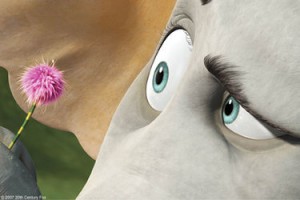



Recent Comments